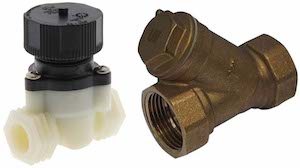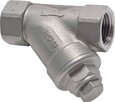Different Types of Pipeline Strainers: Y vs T Strainer

Figure 1: T strainer (left) and Y strainer (right)
Strainers are essential components in pipe systems because they remove debris from the system to keep downstrain components safe and functioning. Y strainers are easier to install and maintain. T strainers, on the other hand, have lower pressure drop and are better suited for heavy-duty applications. This article goes further into the differences between these two types of strainers.
Correctly incorporating strainers into a pipe system protects equipment and processes. They are critical for applications that require clean fluids. The strainers filter out dirt, debris, rust, jointing compound, weld metal, and scale. By filtering out debris, downstrain components will be protected which reduces maintenance costs and downtime, allowing optimal productivity.
View our online selection of Y strainers and order today!
Y type vs T type strainers
Y and T type strainers are commonly used to protect equipment in a piping system. The key differences between t strainer and y strainer are their design, installation orientation, and cost.
Design
A T strainer (Figure 1 left) has a T-shaped body, a removable strainer basket that sits inside the body, and a top access port that opens to provide access to the basket when it needs to be cleaned or replaced. T strainers can collect more particles without getting clogged than Y strainers can, therefore T strainers have lower pressure drop across the strainer.
A Y strainer (Figure 1 right) has a compact, y-shaped design. The mesh strainer branches off from the main flow path, so captured particles do not sit in the way of the flow. However, Y strainers are not designed to hold a lot of debris and can quickly clog. Therefore, Y strainers are better suited to cleaner media and low-pressure applications.
Installation orientation
Due to its design, a T-shaped strainer can only be installed to horizontal piping and must be facing upwards. This limits the design possibilities of the system. A Y-shaped strainer, however, can be installed on horizontal or vertical piping. The only important aspect is that its filter leg must be facing downwards. The Y-shaped strainer has more versatility when fitting into a pipe system.
Cost
When the best strainer is the least expensive strainer, Y strainers are the better choice. Y strainers have a cast housing and therefore are less expensive than T strainers. Reducing the necessary size of the strainer as much as possible before purchasing can also help reduce costs.
Screen types
Strainers used in pipe systems are also differentiated by the type of screen they have. The two primary types of screens are perforated screens and mesh screens.
- Perforated screen: A perforated screen strainer is a single sheet of metal with holes drilled into it in a regular pattern. This type of screen is typically used for applications that focus on capturing relatively large particles only.
- Mesh screen: A mesh screen consists of woven or knitted material, typically metal wires. This creates a grid-like pattern with small openings between wire and fibers. Mesh screen strainers are better suited for filtering relatively small particles.
Materials
The following list consists of the most common materials used for y and T strainers.
- Carbon steel: Carbon steel is best suited for high-pressure and temperature applications. If there is a fire hazard, choose carbon steel.
- Bronze: Bronze is chosen in saltwater environments.
- Cast iron: Cast iron is the most cost-effective choice for moderate applications.
Read our strainer selection article for more details on how to select a strainer for an application.
FAQs
What are the differences between T and Y strainers?
The primary difference is their shape. Y strainers have a Y shape and T strainers have a T shape. Y strainers are suitable for clean media whereas T strainers can handle larger particles.
What does a strainer do?
A strainer stops particles, such as rust and scale, from entering and damaging important and costly system components.





